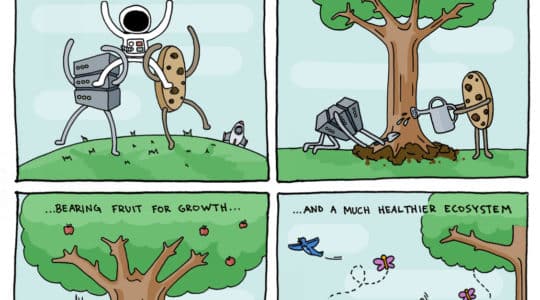
If you’re a mobile app marketer, you know that the cost of acquiring mobile app users just keeps rising. In fact, recent data shows that the cost of acquiring loyal users reached an all-time high in August 2013 as marketers started prepping for the holiday season, spending their Q3 budgets on A/B testing acquisition strategies so their marketing campaigns will be successful in Q4. While the cost of acquiring users is high, there are ways that app marketers can drive down these costs.
Here are five ways that mobile app marketers can lower the costs of acquiring users without sacrificing any aspect of your marketing campaign.
Don’t Stop At Installs – Engage Users
Many mobile app marketers focus on one metric – CPI (cost per install), and while the number of installs was the first and primary KPI for user acquisition in the beginning, it’s important to consider what happens after users install your app. User engagement may soon be integrated into Apple’s ranking algorithm, which means high user engagement can further help users organically discover your app at no cost to you. The higher your app ranks, the less money you’ll have to spend on user acquisition costs. As user engagement is already a part of the ranking algorithm for apps in Google Play, it’s still critical to consider how to maintain loyalty, especially if you’re in a vertical such as health, fitness, or dating where users are more likely to stop using the app after 60 or 90 days, which can then hurt your app’s ranking and force you to spend more money to acquire new users. Some tactics that are known to work to engage users are push notifications and social components that encourage friends to engage each other to continue to use your app, or that target users who behave a certain way to cross-promote another game.
Deeplink With Mobile Ads
On that note, advertisers want to attribute purchases and user engagement beyond the install back to their advertising partners. A critical part of optimizing the funnel beyond the install is making sure users land in the most appropriate location within an app once they have it installed. Deeplinkme and Sparq offers the ability to further drive engagement into a specific point of an app, and Facebook also recently launched this capability with its mobile app ads, enabling app marketers to direct users to a customized, specific location inside of their app, such as a sale, promotion or specific content such as a new album or hotel listing. Though there is a cost to advertising your app using deeplinks, this will encourage engagement within the app which, as mentioned above, will organically help increase your app store rankings and drive down user acquisition costs. Google AdWords extensions can also help encourage conversation within an app by enabling advertisers to point people who search on Google to a specific place in the app. Consider this type of acquisition an investment that keeps on giving back.
Avoid Peak Hours and Days
If your goal is acquisition and you’re looking for ways to drive down mobile app user acquisition costs, you’ll definitely want to avoid the high user acquisition costs that marketers experience during holidays and other special events, such as iPhone launches. In a recent report, W3i noted that the value of new users jumps during long weekends. Holiday weekends are also high in advertiser demand, as CPI rates increased by 65 percent over the 2012 Memorial Day Weekend, for example, with some CPI rates even more than quadrupling the industry standard. Additionally, many advertisers noticed a sharp increase in user acquisition costs during the iPhone 5 launch in 2012. Consider keeping a calendar of holidays and special events and pause your campaigns during these time periods.
Consider Licensing Content
If you really want to drive down user acquisition costs for your mobile app, you may want to reconsider your mobile app’s content strategy at the early stages. One way that mobile developers and publishers can drive down user acquisition costs is to use well-known and recognizable intellectual property, such as characters, stories and brands from entertainment, such as movies and TV. This can also easily provide immediate attention, differentiation and credibility. To see how licensing content can drive down user acquisition costs, consider if with a CPI of $1 a publisher is able to spend $200,000 and thereby obtain 200,000 installs. With a conversion rate of 5%, that should result in 10,000 paying users and an Acquisition Cost Per Paying User (ACPPU) of $20. If the Average Revenue Per Paying User is $40, then the expense of $200,000 generates $400,000 in net revenue and a gross profit of $200,000. However, consider if you chose to develop an app using licensed content. Instead of paying $200,000 (most of it in advance) to generate $400,000 in revenue for the same number of users, you would only need to pay a royalty of 12.5% instead – or $50,000.
Measure ROI
If you want to drive down the cost of user acquisition, it’s important to know what the ROI of your marketing campaigns is so you can spend less overall and more in the right places. There are a variety of channels you can acquire users from, but not each channel may deliver the results you desire, resulting in large ad spends in channels that don’t lead to large amounts of new customers. For example, consider if you shifted your ad spend from a variety of channels including social media, email, SMS, and incentive programs to just social media and incentive programs, reducing your Acquisition Cost Per Paying User (ACPPU) from $40 to $20. However, due to the cost of the particular incentive channel you chose, your Average Revenue Per Paying User decreased from $20 to $10. While your previous gross profit was $200,000, the shift in acquisition channels actually decreased your gross profit to $100,000 — even though you technically drove down your user acquisition costs.
To drive down user acquisitions costs, be sure you’re measuring the ROI of each channel you’re leveraging to acquire users from. Technology such as Swrve, MixPanel and Omniture can help measure the ROI from each acquisition channel, providing insightful in-app analytics into the performance of your campaign. With the combination of top-of-the-funnel analytics in addition to in-app analytics, marketers can identify the sources that are driving the greatest ROI. This is especially helpful if traffic is coming from multiple sources. Of course, be sure you continue to optimize as you measure your ROI per acquisition channel. Though you may be seeing more revenue, your costs per channel may not have actually decreased (or, potentially, may have increased instead.)
Ready to learn more about mobile acquisition? Check out our newest e-book, The Ultimate Guide to Mobile Partner Marketing. Download it here or check out the blog post to learn more!
Author
Becky is the Senior Content Marketing Manager at TUNE. Before TUNE, she handled content strategy and marketing communications at several tech startups in the Bay Area. Becky received her bachelor's degree in English from Wake Forest University. After a decade in San Francisco and Seattle, she has returned home to Charleston, SC, where you can find her strolling through Hampton Park with her pup and enjoying the simple things between adventures with friends and family.




Spot on Kelly. One of the things to keep in mind with marketing mobile apps is to make the most of every possible avenue.
Screenshots and gameplay videos are weak experiences compared to actual engagement. In the same way, we’re much more likely to buy a piece of clothing after trying it on, so it’s important to offer an engaging experience asap.
That’s why we’ve seen a rise of Free apps with in-app purchase models, BUT a customer still has to take the time to download the app before they know if it’s something they want.
We (https://app.io) offer a way to let customers play an app in the browser (without the need to download), which provides a stronger experience and a higher chance of conversion.
Think of it as ‘try-before-you-buy’ – Here’s an example: https://app.io/prismadrop
I hope that this extra piece of information (and yes, promotion) assists app developers in further marketing their apps with a low user acquisition cost (yes, we have a free plan).
– Diesel
Thanks for the comment, Diesel. Can you shoot me an email at [email protected]? I’d love to chat with you more about app.io. Thanks!
Emailed. 🙂
Thats what I am trying to do with my game Bomb Attack Max Android https://t.co/NwGQ15E3sg